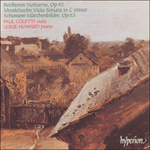Buoyed by the successful premiere of the ‘Rhenish’ Symphony in February 1851, Schumann composed another of his adaptable chamber-music miniatures early the following month: the
Märchenbilder, Op 113 for piano with either viola (the composer’s first choice) or violin. The stimulus for these four ‘Fairy-tale Pictures’ was the virtuoso violinist Wilhelm Joseph von Wasielewski, whom Schumann had recruited from Leipzig as leader of the Düsseldorf orchestra. Whatever their specific fairy-tale background (the composer left no clues), the four pieces seem to conjure in alternation the twin fictional personas of Schumann’s youth. The wistful musings of the dreamer Eusebius, expressed in delicate interplay between the two instruments, are countered by the impetuous Florestan in the rhythmically insistent second movement. The two personas appear successively in the third movement, whose brilliant outer sections enfold a romantic interlude in an exotically remote key (B major, after D minor). Eusebius has the last word in the finale, a lullaby marked
Langsam, mit melancholischem Ausdruck (‘Slowly, with melancholy expression’), and perfectly fashioned for the dusky tones of the viola.
from notes by Richard Wigmore © 2012
Requinqué par la première triomphale de sa Symphonie «Rhénane», en février 1851, Schumann rédigea, début mars, une autre de ses miniatures de chambre modulables: les
Märchenbilder op. 113 pour piano et alto (son premier choix) ou violon. Ces quatre «Images de conte de fées», il fut incité à les écrire par le violoniste virtuose Wilhelm Joseph von Wasielewski, qu’il avait recruté à Leipzig comme premier violon de l’Orchestre de Düsseldorf. Même si Schumann ne nous dit rien des contes utilisés, ces quatre pièces semblent évoquer en alternance les doubles imaginaires de sa jeunesse. Les songeries nostalgiques du rêveur Eusebius, exprimées dans le subtil jeu entre les deux instruments, sont contrées par l’impétueux Florestan dans le deuxième mouvement, rythmiquement insistant. Puis tous deux se succèdent dans le troisième mouvement, dont les brillantes sections extrêmes étreignent un interlude romantique sis dans une tonalité exotiquement éloignée (si majeur, après ré mineur). Eusebius a le dernier mot dans le finale, une berceuse marquée
Langsam, mit melancholischem Ausdruck («Lentement, avec une expression mélancolique») et idéalement façonnée pour les sonorités crépusculaires de l’alto.
extrait des notes rédigées par Richard Wigmore © 2012
Français: Hypérion
Von der erfolgreichen Premiere der Rheinischen Symphonie (im Februar 1851) ermutigt, komponierte Schumann zu Beginn des folgenden Monats eine weitere Serie von variablen Kammermusik-Miniaturen, die
Märchenbilder op. 113 für Klavier mit entweder Bratsche (die erste Wahl des Komponisten) oder Violine. Die Anregung für diese Stücke hatte der Geigenvirtuose Wilhelm Joseph von Wasielewski geliefert, den Schumann aus Leipzig als Konzertmeister des Düsseldorfer Orchesters angeworben hatte. Es ist nicht ersichtlich, ob und wie hier auf spezifische Märchen Bezug genommen wird, doch scheinen die vier Stücke abwechselnd die beiden fiktiven Figuren aus Schumanns Jugend heraufzubeschwören. Die wehmütigen Grübeleien des Träumers Eusebius, die in dem zarten Zusammenspiel der beiden Instrumente ausgedrückt werden, sind dem impulsiven Florestan in dem rhythmisch hartnäckigen zweiten Satz gegenübergestellt. Im dritten Satz treten die beiden Figuren nacheinander auf, wo brillante Außenteile ein romantisches Zwischenspiel in einer exotischen, weitentfernten Tonart (H-Dur nach d-Moll) umrahmen. Eusebius hat im Finale das letzte Wort, ein Schlaflied, das mit
Langsam, mit melancholischem Ausdruck überschrieben ist und ideal zu dem dunklen Timbre der Bratsche passt.
aus dem Begleittext von Richard Wigmore © 2012
Deutsch: Viola Scheffel


 Beethoven, Mendelssohn & Schumann: Music for viola and piano
Beethoven, Mendelssohn & Schumann: Music for viola and piano
